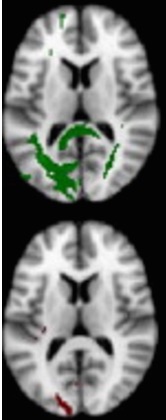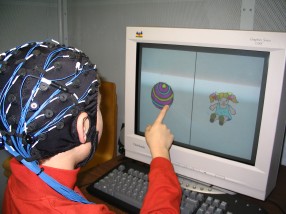Research
Campus Maps
Exploring the Brain’s Language Network
About Dr. Marc Joanisse

Marc Joanisse is a Professor in the Psychology Department and Neuroscience Graduate Program at Western. In addition he also holds an appointment as an Affiliated Scientist at Haskins Laboratories in New Haven Connecticut. Dr. Joanisse's research examines the neural underpinnings of first- and second-language learning in children and adults, with a special focus on the interplay between spoken and written language. This includes studying the brain bases of reading ability and disability across the lifespan, using a wide variety of experimental techniques including fMRI, ERP and eyetracking.
Overview of our lab
Spoken language develops very quickly in young children, with most individuals producing their first words by the age of one, and full sentences by the age of two and a half. In contrast, reading is a skill that develops relatively slowly in children, and approximately 10% of children have a significant reading disorder. What makes reading so different from spoken language, and why do some children develop reading disorders despite having normal abilities in other respects? Research in Dr. Joanisse’s lab is exploring how this variability in how we learn to read emerges from such factors as the brain architectures supporting reading developing as well as individual variation in children’s spoken language experience. Our lab also examines how the bilingual experience changes how the brain is organized for language, with a special focus on the significant individual variability we see in second language learning success.
Current projects
The Brain’s Reading Network
There is no single ‘reading centre’ in the brain. Instead, reading is the result of multiple neurocognitive mechanisms that involve a range of brain regions connected into a complex reading network. We are currently using neuroimaging to uncover the cognitive and neural underpinnings of this reading network, with a special focus on how this differs across individuals of varying reading strengths. Recent research has used functional Magnetic Resonance Imaging (fMRI) and diffusion tensor imaging (DTI) to examine how the structure of this reading network varies from one reader to another, and how this variability maps onto distinct markers of reading skills. We have also used these same approaches to examine why reading breaks down in patients with acquired dyslexia following brain damage.
Spoken Language Learning
Some of the work in our lab focuses on a phenomenon known as statistical language learning. Statistical language learning involves the discovery of the predictable patterns that exist within natural language, and may contribute to how individuals acquire their native language. Using behavioural and neuroimaging techniques, our lab is investigating how language learners use the patterns in a novel language to learn new words, and whether this learning depends on language-specific or general cognitive abilities.
Language Disorders in Children
Our work on child language development also focuses on reading and language impairments in children. In particular, she is interested in the role of phonology in dyslexia and specific language impairment (SLI). Using behavioural measures, eye tracking, ERP, and MRI, she hopes to examine how profiles of phonological abilities can be used to differentiate dyslexia and SLI and predict responses to intervention.
Reading in Bilingual Children:
Our current research on bilingualism in childhood us examining the behavioural and neural correlates of first- (L1) and second-language (L2) reading performance in bilingual 4th grade children, as compared to L1 reading performance in monolingual children. This research examines the brain bases of reading through the use of eye-tracking and electroencephalography (EEG). Children's reading performance is also being compared to that of young adults (18-30 years) to examine the developmental trajectory of monolingual and bilingual reading performance.
Second Language Learning in Adults:
The primary goal of this research is to characterize the functional and structural neural substrates of second language acquisition and processing, specifically how they relate to proficiency and age of acquisition. To answer my research questions, we are using several techniques including fMRI, diffusion tensor imaging, and event-related potentials.

Figure 1 - Diffusion-tensor imaging scans, showing intact white-matter connections in a typical adult (top) and impaired connectivity in a patient with reading impairment following stroke (bottom).

Figure 2 -Child participating in one of our lab’s studies using EEE.
![]()
Figure 3 -Child participating in one of our lab’s studies using eyetracking.

